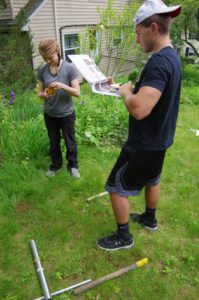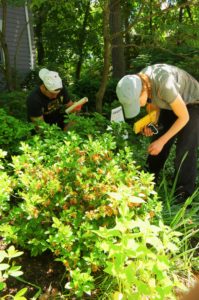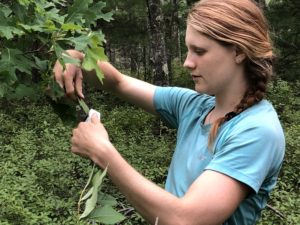By Christopher Neill
This article was first published in the fall edition of Native Plant News and is reprinted with the permission of the author.
At dawn on a June morning in 2017, Megan Shave, a member of my summer field research team at the Woods Hole Research Center, parked on a residential street in the leafy inner suburbs of Boston, MA. She entered a previously chosen suburban yard, set a timer for 10 minutes, and watched and listened for birds. When the timer beeped, she wrote down on a data sheet everything she had seen and heard, then drove to the next yard.

In a suburban Boston yard, Emily Tanner and Brett Barnard install a small Plant Root Simulator (PRS™).
By the time people in the neighborhood had headed off to their workdays two hours later, Megan had joined up with three other team members for a day-long, intensive survey of a single yard in a nearby town. Like an eco-SWAT team, they noted every plant species and the lawn or garden feature in which they occurred. They measured the species and diameter of every tree, set traps to measure the diversity and abundance of bees and crawling insects, and took soil samples. They deployed small strips of special resins, designed to capture soil nutrients, that they will collect on a future visit. Before leaving, they created a detailed sketch map of the yard.
Since then, similar teams have surveyed yards in exactly the same way in metropolitan Baltimore, Minneapolis-St. Paul, Phoenix, Los Angeles, and Miami. Teams in all six cities are part of a nationwide study nicknamed the Yard Futures Project, which continues through 2020. The project aims to measure—across yards and across large regions—how the management of residential single-family house lots influences the structure, biodiversity, and function of residential ecosystems. Our study is one of the most detailed scientific investigations into the broad ecological functioning of the suburban landscapes in which 51 percent of Americans now live.
This is critically important because residential areas continue to expand, and their influence on biodiversity and what scientists call ecosystem services—such as conserving and filtering water, cooling hot spaces, and retaining carbon—is poorly understood. Yet suburban yards could play a vitally important role in supporting more biodiversity and ecosystem services, which also make suburbs enjoyable places for people to live. One goal of our project is to help suburban landscapes become more successful in all these ways.

PRS ™ probes measure the soil nutrients available to plants. All photos by © Christopher Neill.
Here’s how we have structured our project: Within each metropolitan region, research teams visit yards that fall into four main categories, or “treatments”: (1) typical or passive homeowner-conducted management without fertilizer or pesticides; (2) intensive management with fertilizer and pesticides and hiring of a lawn-care company; (3) wildlife friendly management that includes certification by the National Wildlife Federation: and (4) hydrological management that includes specific activities to reduce water use or water runoff. In each place, teams also compare the structure of yards with the structure of large natural areas in the region, and the smaller remnants of natural areas that residential neighborhoods often now abut.
We know that the way homeowners manage their yards in Phoenix might not have the same consequences as in Boston. But that’s the point. We want to learn about those differences and put them into the service of making backyards maintain more natural functions, and over more of the country.
This project grew out of previous work by the research team that tested how building suburban residential environments homogenizes ecosystems by pushing the landscape towards similar microclimates, plant communities, and nutrient cycling patterns. By comparing our yard maps to our detailed inventories of species and ecological responses, we aim to make our ever-expanding data on yard structures a more useful predictor of biodiversity across U.S. suburban regions. With its mission of conserving and promoting New England native plants to ensure healthy, biodiverse landscapes, Native Plant Trust is partnering with us to share our research with an engaged audience.

Emily Tanner measures water vapor exchange in an oak leaf in Myles Standish State Forest in southwestern Massachusetts.
The Yard Futures Project has funding from the Macrosystems Biology program of the National Science Foundation. Peter Groffman leads the project from the City University of New York’s Advanced Science Research Center. The project team includes social as well as natural scientists because we want to understand not just what people do in their yards, but why they do it. Now that our project is in its final year, we have collected and published a lot of scientific data, and we have a lot of fascinating stories to tell. We look forward to sharing our articles on Yard Futures Project in the coming months.
About the Author
Christopher Neill, Ph.D., is a Senior Scientist at Woodwell Climate Research Center in Falmouth MA, and a co-principal investigator on the Yard Futures Project responsible for science in the Boston Metropolitan Region.
***
Each author appearing herein retains original copyright. Right to reproduce or disseminate all material herein, including to Columbia University Library’s CAUSEWAY Project, is otherwise reserved by ELA. Please contact ELA for permission to reprint.
Mention of products is not intended to constitute endorsement. Opinions expressed in this newsletter article do not necessarily represent those of ELA’s directors, staff, or members.

